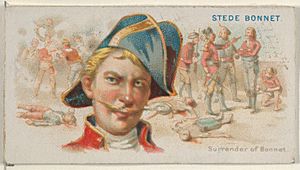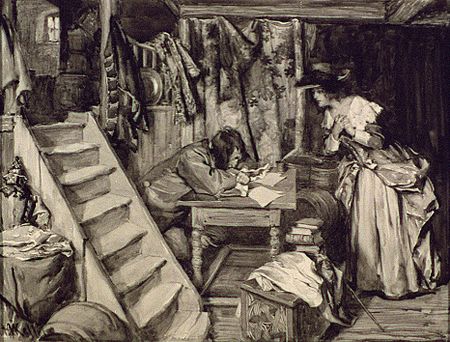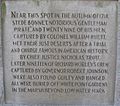Stede Bonnet facts for kids
Quick facts for kids
Stede Bonnet
|
|
|---|---|
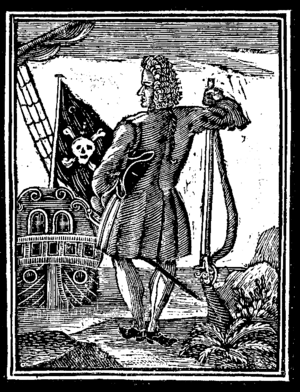
Engraving of Bonnet from A General History of the Pyrates (1724)
|
|
| Born | 1688 |
| Died | (aged 30) |
| Cause of death | Executed by hanging |
| Spouse(s) |
Mary Allamby
(m. 1709) |
| Children | Edward Bonnet, Allamby Bonnet, Stede Bonnet, Mary Bonnet |
| Piratical career | |
| Nickname | The Gentleman Pirate |
| Type | Pirate |
| Allegiance | None |
| Years active | 1717–1718 |
| Rank | Captain |
| Base of operations | Atlantic Ocean, along East Coast of the British Colonies, and Caribbean Sea |
| Commands | Revenge, later renamed Royal James |
| Battles/wars | Battle of Cape Fear River |
Stede Bonnet (born in 1688, died December 10, 1718) was a pirate from the early 1700s. He was known as the Gentleman Pirate because he was a rich landowner before he became a criminal. Bonnet was born into a wealthy English family on the island of Barbados. He inherited his family's land after his father passed away in 1694.
Even though he knew nothing about sailing, Bonnet decided to become a pirate in late 1716 or early 1717. He bought a ship called the Revenge. With his paid crew, he sailed along the East Coast of what is now the United States. He captured other ships and burned those from Barbados.
Bonnet sailed towards Nassau in the Bahamas. This place was a safe haven for pirates, known as the "Republic of Pirates". On the way, he was badly hurt in a fight with a Spanish warship. After reaching Nassau, Bonnet met Edward Teach, who was famously known as Blackbeard. Bonnet was too injured to lead his crew, so he let Blackbeard take temporary command of his ship.
Blackbeard and Bonnet sailed together, capturing merchant ships along the East Coast. They separated in December 1717. Bonnet tried to capture a ship called the Protestant Caesar, but he failed. His crew then left him to join Blackbeard on his ship, the Queen Anne's Revenge. Bonnet stayed on Blackbeard's ship as a guest. He did not command a crew again until summer 1718. At that time, he received a pardon from the governor of North Carolina, Charles Eden. This pardon allowed him to become a privateer and attack Spanish ships.
Bonnet wanted to go back to piracy but did not want to lose his pardon. So, he used the fake name "Captain Thomas" and changed his ship's name to Royal James. By July 1718, he was back to being a pirate.
In August 1718, Bonnet anchored the Royal James in the Cape Fear River. He needed to repair his ship there. In late August and September, Colonel William Rhett led a naval group to fight pirates on the river. He had permission from South Carolina's governor, Robert Johnson. Rhett's men and Bonnet's men fought for hours in the Battle of Cape Fear River. Bonnet's pirates were outnumbered and eventually gave up. Rhett arrested the pirates and took them to Charles Town (now Charleston, South Carolina) in early October.
Bonnet escaped on October 24 but was quickly caught again on Sullivan's Island. On November 10, Bonnet was put on trial. He was accused of two acts of piracy. Judge Nicholas Trott sentenced him to death. Bonnet wrote to Governor Johnson asking for mercy, but the governor agreed with the judge's decision. Bonnet was hanged in Charles Town on December 10, 1718.
Contents
Becoming a Pirate Captain
In the spring of 1717, Stede Bonnet decided to become a pirate. This was unusual because he knew nothing about life on a ship. He hired a local shipyard to build him a ship. It was a sixty-ton sloop with ten guns, and he named it the Revenge. Most pirates usually took ships by mutiny (crew rebellion) or by attacking them.
Bonnet hired a crew of more than seventy men. He relied on his quartermaster and other officers for their sailing knowledge. Because of this, his crew did not respect him much. Also, Bonnet paid his crew wages, which was different from most pirates who shared their stolen goods. Reports said he left Carlisle Bay, Barbados, secretly at night.
First Pirate Journeys
Bonnet's first trip took him to the coast of Colony of Virginia, near the Chesapeake Bay. There, he captured and robbed four ships. He burned a ship from Barbados called the Turbet so that news of his crimes would not reach his home island. He then sailed north to New York City, taking two more ships. He got supplies and released prisoners at Gardiners Island.
By August 1717, Bonnet was back in the Carolinas. He attacked two more ships: a brigantine from Boston and a sloop from Barbados. He took everything from the brigantine. He brought the Barbadian sloop, which was full of cargo, to an inlet off North Carolina. He used it to repair the Revenge. After the Revenge was fixed, the Barbadian ship was taken apart for wood and then burned.
In September 1717, Bonnet headed for Nassau. This was a famous pirate hideout on the island of New Providence in the Bahamas. On the way, he fought a Spanish man-of-war (a warship). The Revenge was badly damaged, Bonnet was seriously hurt, and half of his crew were killed or injured. When he arrived in Nassau, Bonnet replaced his lost crew members and fixed the Revenge. He also added more guns, bringing the total to twelve.
Working with Blackbeard
While in Nassau, Bonnet met Captain Benjamin Hornigold and Edward Teach (Blackbeard) for the first time. Blackbeard would play a big part in Bonnet's life. Because of his injuries, Bonnet temporarily gave command of the Revenge to Blackbeard. Bonnet stayed on board as a guest of the more experienced pirate captain.
Blackbeard and Bonnet sailed north to Delaware Bay, where they robbed eleven ships. On September 29, 1717, the Revenge, now led by Blackbeard, captured the sloop Betty, which was full of Madeira wine. A captain whose ship was taken on October 12 said Bonnet was walking around in his nightshirt, not in command, and still sick from his wounds. The Revenge later captured and looted the Spofford and Sea Nymph, which were leaving Philadelphia. On October 22, the Revenge stopped and robbed the Robert and Good Intent for their supplies.
Separating from Blackbeard
Blackbeard and Bonnet left Delaware Bay and went back to the Caribbean in November. They continued to be successful pirates. On November 17, a 200-ton ship called the Concorde was attacked near Martinique. The ship's officer said the pirate ships had 12 guns and 120 men, and 8 guns and 30 men. The Concorde crew fought back but gave up after the pirates fired many cannons and muskets at them. Blackbeard took the Concorde and sailed south. He renamed it Queen Anne's Revenge, possibly to insult King George I.
Sometime after December 19, Bonnet and Blackbeard went their separate ways. Bonnet sailed into the western Caribbean. In March 1718, he met a 400-ton merchant ship called Protestant Caesar off Honduras. The ship got away from him, and his crew became unhappy. When Bonnet met Blackbeard again soon after, Bonnet's crew left him to join Blackbeard. Blackbeard put one of his men, Richards, in charge of the Revenge. Bonnet was surprised that Blackbeard had betrayed him. He found himself a guest on the Queen Anne's Revenge. Bonnet told a few loyal crew members that he wanted to stop being a criminal and live in Spain or Portugal. Bonnet would not be in command of a ship again until the summer of 1718.
Under Captain Richards, the Revenge captured a Jamaican sloop, the Adventure. Its captain, David Herriot, joined the pirates. Blackbeard now had three ships. Bonnet went with Blackbeard to South Carolina. Blackbeard's four ships blocked the port of Charles Town in late spring 1718. Blackbeard and Bonnet needed a place to rest and repair their ships. They headed north to Topsail Island, where the Queen Anne's Revenge got stuck and was lost.
Leaving the other three ships at Topsail Island, Blackbeard and Bonnet went ashore. They traveled to Bath, the capital of North Carolina. There, both men accepted pardons from Governor Charles Eden. This was part of King George's Act of Grace, which meant they had to promise to stop piracy forever. Blackbeard quietly went back to Topsail Island. Bonnet stayed in Bath to get permission to take the Revenge to Denmark's Caribbean colony of St. Thomas. He planned to buy a letter of marque there and become a privateer against Spanish ships. Governor Eden gave Bonnet this permission.
Returning to Pirate Command
Bonnet went back to Topsail Island. He found that Blackbeard had left most of their old crew there. Blackbeard had also stolen most of the supplies from the Revenge and two other ships. He had sailed away on the sloop Adventure with all the stolen goods. In late June or early July 1718, Bonnet took command of the Revenge again. Few, if any, of his original crew from Barbados were still on board. Bonnet made his crew stronger by rescuing many men whom Blackbeard had left on a sandbar at Topsail Island.
Soon after Bonnet took command, the crew of a small boat told him that Blackbeard was anchored in Ocracoke Inlet. Bonnet immediately set sail to find his dishonest former partner. But he could not find him, and Bonnet never saw Blackbeard again.
Bonnet still hoped to reach St. Thomas and get his letter of marque. But two big problems made him think about going back to piracy. First, Blackbeard had stolen the food and supplies his men needed. Second, it was hurricane season in St. Thomas, which would last until autumn. However, going back to piracy meant losing his pardon.
New Name, Old Habits
To try and keep his pardon, Bonnet used the fake name "Captain Thomas". He also changed the Revenge's name to the Royal James. The name Royal James might have been a reference to Prince James Stuart.
Bonnet tried to hide his return to piracy by pretending to trade with the next two ships he robbed. But soon after, Bonnet stopped pretending and went back to full piracy. In July 1718, he sailed north to Delaware Bay. There, he robbed eleven more ships. He took several prisoners, and some of them joined his pirate crew. Bonnet usually let most of his captured ships go after robbing them. But he kept the last two ships he captured: the sloops Francis and Fortune.
On August 1, 1718, the Royal James and the two captured sloops sailed south from Delaware Bay. The captured sloops fell behind, and Bonnet threatened to sink them if they did not stay closer. During the trip, Bonnet and his crew divided their stolen goods. Each person got about £10 or £11. This is the only time Bonnet is known to have done this. It suggests he had stopped paying regular wages to his crew.
Twelve days after leaving Delaware Bay, Bonnet entered the estuary of the Cape Fear River. He anchored near the mouth of a small waterway, now called Bonnet's Creek. The Royal James was leaking badly and needed repairs. Soon after, a small boat called a shallop entered the river and was captured. Bonnet had the shallop broken up to help repair the Royal James. The repair work was done, partly or fully, by the prisoners Bonnet had captured. Bonnet even threatened one man with being left alone on an island if he did not work with the slaves to fix the Royal James. Bonnet stayed in the Cape Fear River for the next 45 days. According to Bonnet's boatswain, Ignatius Pell, the pirates planned to wait out the hurricane season there.
The Battle of Cape Fear River
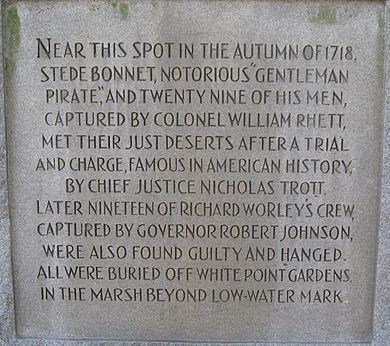
By the end of August, news reached Charles Town that Bonnet's ships were in the Cape Fear River. Robert Johnson, the governor of South Carolina, told Colonel William Rhett to lead a naval group against the pirates. This was even though the Cape Fear River was in North Carolina. After a false start because another pirate ship appeared near Charles Town, Rhett arrived at the mouth of the Cape Fear River on September 26. He had two sloops with eight guns each, the Henry and the Sea Nymph, and 130 militia men.
Bonnet first thought Rhett's ships were merchant ships. He sent three canoes to capture them. Rhett's main ship, the Henry, got stuck in the river mouth. This allowed Bonnet's canoe crews to get close. They realized the heavily armed ships were enemies and quickly returned to warn Bonnet. The sun had set by the time the rising tide freed the Henry.
The 46 pirates were spread among the three sloops. During the night, Bonnet gathered all of them onto the Royal James. He planned to fight his way out to sea in the morning. He did not want to risk the Cape Fear River's narrow channels in the dark. Bonnet also wrote a letter to Governor Johnson, threatening to burn all the ships in Charles Town Harbour.
The Fight Begins
At daybreak, on September 27, 1718, Bonnet sailed towards Rhett's force. All three sloops opened fire, starting the Battle of Cape Fear River. The two South Carolina sloops split up to try and surround the Royal James. Bonnet tried to avoid this trap by steering the Royal James close to the river's western shore. But he ran aground (got stuck) in the process. Rhett's ships also ran aground, leaving only the Henry close enough to fire at the Royal James.
The battle was stuck for the next five or six hours, with all the ships unable to move. Bonnet's men had an advantage because their ship's deck was tilted away from their enemies. This gave them cover. But the Henry's deck was tilted towards the pirates, leaving Rhett's men open to musket fire. Bonnet's group had twelve people injured or killed. Rhett's 70-man crew had ten killed and fourteen wounded.
Most of Bonnet's men fought with great energy. They dared their enemies to board and fight hand-to-hand. They even tied a knot in their flag as a fake signal for help. Bonnet himself walked the deck with a pistol, threatening to kill any pirate who hesitated. However, some of the prisoners who had been forced to join the pirate crew refused to fire at Rhett's men. One barely escaped death from Bonnet in the confusion.
The battle ended when the rising tide freed Rhett's sloops. But the Royal James remained stuck. Bonnet was helpless. He watched as the enemy ships fixed their ropes and moved in to board his stuck ship. Bonnet's men were outnumbered almost three to one. They would have had little chance of winning a boarding fight. Bonnet ordered his gunner, George Ross, to blow up the Royal James's gunpowder storage. Ross tried, but the rest of the crew stopped him and surrendered. Rhett arrested the pirates and returned to Charles Town with his prisoners on October 3, 1718.
Escape, Capture, and Execution
In Charles Town, Bonnet was kept separate from most of his crew. He was held for three weeks with his boatswain, Ignatius Pell, and his sailing master, David Herriott. They were kept at the home of Town Marshal Nathaniel Partridge. The rest of the crew were held outside Charles Town.
On October 24, Bonnet and Herriott escaped. They likely had help from a local merchant named Richard Tookerman. Governor Johnson immediately offered a £700 reward for Bonnet's capture. He sent search teams to find him. Bonnet and Herriott, along with a slave and a Native American, got a boat. They headed for the north shore of Charles Town Harbour. But bad winds and a lack of supplies forced them onto Sullivan's Island.
Governor Johnson sent a group led by Rhett to Sullivan's Island to hunt for Bonnet. The group found Bonnet after a long search and opened fire. Herriott was killed, and the two slaves were wounded. Bonnet surrendered and was taken back to Charles Town. While he waited for his trial, some people in the city tried to cause trouble to support him. Authorities later said this event almost led to the town being burned and the government being overthrown. Bonnet likely waited for his execution in the Court of Guard, a guardhouse in the city.
The Trial and Final Days
On November 10, 1718, Bonnet was brought to trial before Sir Nicholas Trott. Trott was acting as a judge for sea crimes. Trott had already judged Bonnet's crew and sentenced most of them to hang. Bonnet was officially accused of only two acts of piracy, against the Francis and the Fortune. The commanders of these ships were there to speak against Bonnet. Ignatius Pell, Bonnet's boatswain, had agreed to testify against Bonnet's crew. He also testified, somewhat unwillingly, against Bonnet.
Bonnet said he was not guilty. He defended himself without a lawyer. He questioned the witnesses, but it did not help much. He also called a witness to speak about his good character. Judge Trott gave a very strong summary of the evidence, and the jury found Bonnet guilty. Two days later, after giving Bonnet a serious speech about not following Christian duties, Trott sentenced him to death.
While waiting for his execution, Bonnet wrote to Governor Johnson. He begged for mercy and promised to have his own arms and legs cut off as proof that he would never commit piracy again. Charles Johnson wrote that Bonnet's desperate state made many people in Carolina feel sorry for him, especially women. London newspapers later reported that the governor delayed his execution seven times. Bonnet was finally hanged at White Point Garden, in Charles Town, on December 10, 1718.
Stede Bonnet's Legacy
Pirate Captain's Power
How much power a pirate captain truly had over his crew was often unclear. Unlike government captains, they did not have official laws to support their authority. Many pirate captains were chosen by their crews and could be removed by them too. Because Bonnet did not know much about sailing, he was in an even weaker position than other pirate captains. This was clear when Blackbeard completely took over his command. Early in Bonnet's pirate career, his crew seemed less loyal to him and preferred the more exciting and experienced Blackbeard.
At his trial, Bonnet tried to make it seem like he had little power over his pirate crew. He told the court that his crew committed piracy against his will. He said he had warned them he would leave if they did not stop robbing ships. He also stated that he had been asleep when the sloop Francis was captured. The court did not believe him. Boatswain Ignatius Pell testified that Bonnet's quartermaster, Robert Tucker, had more power than Bonnet. Having a powerful quartermaster was common among pirate crews back then.
However, Bonnet's crew saw him as a leader. It seems likely that after he rescued Blackbeard's abandoned crewmen, he became an equal commander on the Royal James. He seemed to be trusted with the crew's treasure. He also made most of the important decisions, like where the ship would go and which vessels to attack. Most importantly, in Delaware Bay, he ordered two of his crew to be punished for breaking rules. Pirates did not easily accept such punishments. They disliked how often this punishment was used in the navy and merchant ships they came from. So, only a leader who had his crew's obedience could successfully order such penalties.
Bonnet's Pirate Flag
Bonnet's pirate flag is often shown as a white skull above a horizontal long bone, with a heart and a dagger, all on a black background. Even though this flag appears a lot in pirate stories today, no old sources from Bonnet's time describe it or say it belonged to him. This version of Bonnet's flag probably comes from a collection of pirate flags on an old manuscript. It was given to Britain's National Maritime Museum in 1939. Bonnet's crew and people at the time usually said he flew a "bloody flag," which likely meant a dark red flag. There is also a report from 1718 that Bonnet flew a "death's head flag" (a skull flag) when chasing the Protestant Caesar. This report does not mention any color, bone, heart, or dagger.
Walking the Plank Myth
Some stories say Bonnet was one of the few pirates who made prisoners walk the plank. However, no sources from his time mention Bonnet forcing prisoners to walk the plank. Experts today, like Marcus Rediker, a history professor, generally agree that the idea of pirates making prisoners walk the plank comes from a much later time than Bonnet's.
Bonnet in Popular Culture
Bonnet has appeared many times in books and stories. His life was turned into a story by French author Marcel Schwob in his book Imaginary Lives. He is a main character in Tim Powers' book On Stranger Tides, along with other famous pirates like Blackbeard. In this novel, Bonnet becomes a pirate after Blackbeard tricks him. Kate Bonnet: The Romance of a Pirate's Daughter, by American author Frank R. Stockton, is a funny book about a made-up daughter of Bonnet named Kate.
Bonnet also appears in video games, such as Sid Meier's Pirates! and Assassin's Creed IV: Black Flag. In the 1941 movie The Devil and Daniel Webster, the Devil calls Bonnet to join a jury of the damned.
A plaque honoring Bonnet stands near Bonnet's Creek in Southport, North Carolina, on the Cape Fear River. The Yacht Basin Provision Company also holds an annual Stede Bonnet Regatta near Southport. This event remembers the famous pirate's race to the ocean.
The radio show This American Life had a segment about pirates on May 5, 2017. In the beginning, host Ira Glass spoke to producer Elna Baker about Stede Bonnet's life. The podcast Real Pirates talks about Bonnet and Blackbeard in five episodes. It features Stede Bonnet's biographer Jeremy R. Moss and pirate historians.
The comedy TV series Our Flag Means Death, created by David Jenkins, stars Rhys Darby as Stede Bonnet and Taika Waititi as Blackbeard. Jenkins shows a romantic relationship between the two.
On April 11, 2022, Theatre Three in Dallas, Texas, showed the first performance of the musical comedy Stede Bonnet: A F*cking Pirate Musical. Nicole Neely wrote the story for the play. Clint Gilbert wrote the music and lyrics. Danielle Georgiou directed and choreographed the show. Danny Anchondo, Jr. directed the music.
Images for kids
See also
 In Spanish: Stede Bonnet para niños
In Spanish: Stede Bonnet para niños


